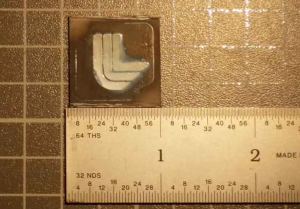If you thought that the current 3D printing technologies, such as FDM, SLS, SLA, and Jetting were advancing rapidly, then wait until you hear about this new technology. Researchers at the Lawrence Livermore National  Laboratory have come up with a technique which could be described as an entirely new 3D printing paradigm.
Laboratory have come up with a technique which could be described as an entirely new 3D printing paradigm.
The technology is based on electrophoretic deposition (EPD), which has been used for nearly a century within the auto industry to prime vehicles before painting them. The way it works is simple. The body of the car is given a negative charge, while the liquid primer is given a positive charge. The opposite charges create a bond between the two materials. Other applications for EPD are for painting cermaics, and other materials, and even for depositting living cells on a surface. Up until now though, there has been no way to control where the materials would be placed. Manufacturers were only able to deposit a material across an entire object. There was no way to selectively place it in certain spots.
The researchers were able to use a process called light-directed electrophoretic deposition, which uses photoconductive electrodes and DC electrical fields to target and then build up a material on a certain area. Wherever the light came in contact with the photoconductors surface, they were able to build material on that spot. This has led them to be able to produce very accurate multi-material composites.
“We have presented a novel electrophoretic deposition technique based on using light to pattern materials on a photoconductive layer. This represents a large step in advancing electrophoretic deposition as a method of fabricating complex 3D patterned composites,” said Andrew Pascall, research engineer and lead author.
Basically what the researchers have done is find a way to make traditional EPD gain an extra dimension. Instead of only being able to deposit a single layer of material across an entire surface, the light-directed EPD allows them to build on top of that material, as many layers as they wish, creating 3D objects. It’s another form of 3D printing, that if scaled up could be extremely accurate, and a faster way to go about additive manufacturing. One of the potential applications for this new technology, which allows for a more accurate creation of void areas within a printed object, is for the 3D printing of veins and arteries within a printed organ.
There is still research to be done but this technology could have huge implications on the future of the 3D printing industry in general. You can talk more about light-directed EPD at the 3dprintboard forum thread. The full report on the research can be found here.
Subscribe to Our Email Newsletter
Stay up-to-date on all the latest news from the 3D printing industry and receive information and offers from third party vendors.
You May Also Like
Profiling a Construction 3D Printing Pioneer: US Army Corps of Engineers’ Megan Kreiger
The world of construction 3D printing is still so new that the true experts can probably be counted on two hands. Among them is Megan Kreiger, Portfolio Manager of Additive...
US Army Corps of Engineers Taps Lincoln Electric & Eaton for Largest 3D Printed US Civil Works Part
The Soo Locks sit on the US-Canadian border, enabling maritime travel between Lake Superior and Lake Huron, from which ships can reach the rest of the Great Lakes. Crafts carrying...
Construction 3D Printing CEO Reflects on Being Female in Construction
Natalie Wadley, CEO of ChangeMaker3D, could hear the words of her daughter sitting next to her resounding in her head. “Mum, MUM, you’ve won!” Wadley had just won the prestigious...
1Print to Commercialize 3D Printed Coastal Resilience Solutions
1Print, a company that specializes in deploying additive construction (AC) for infrastructure projects, has entered an agreement with the University of Miami (UM) to accelerate commercialization of the SEAHIVE shoreline...






























